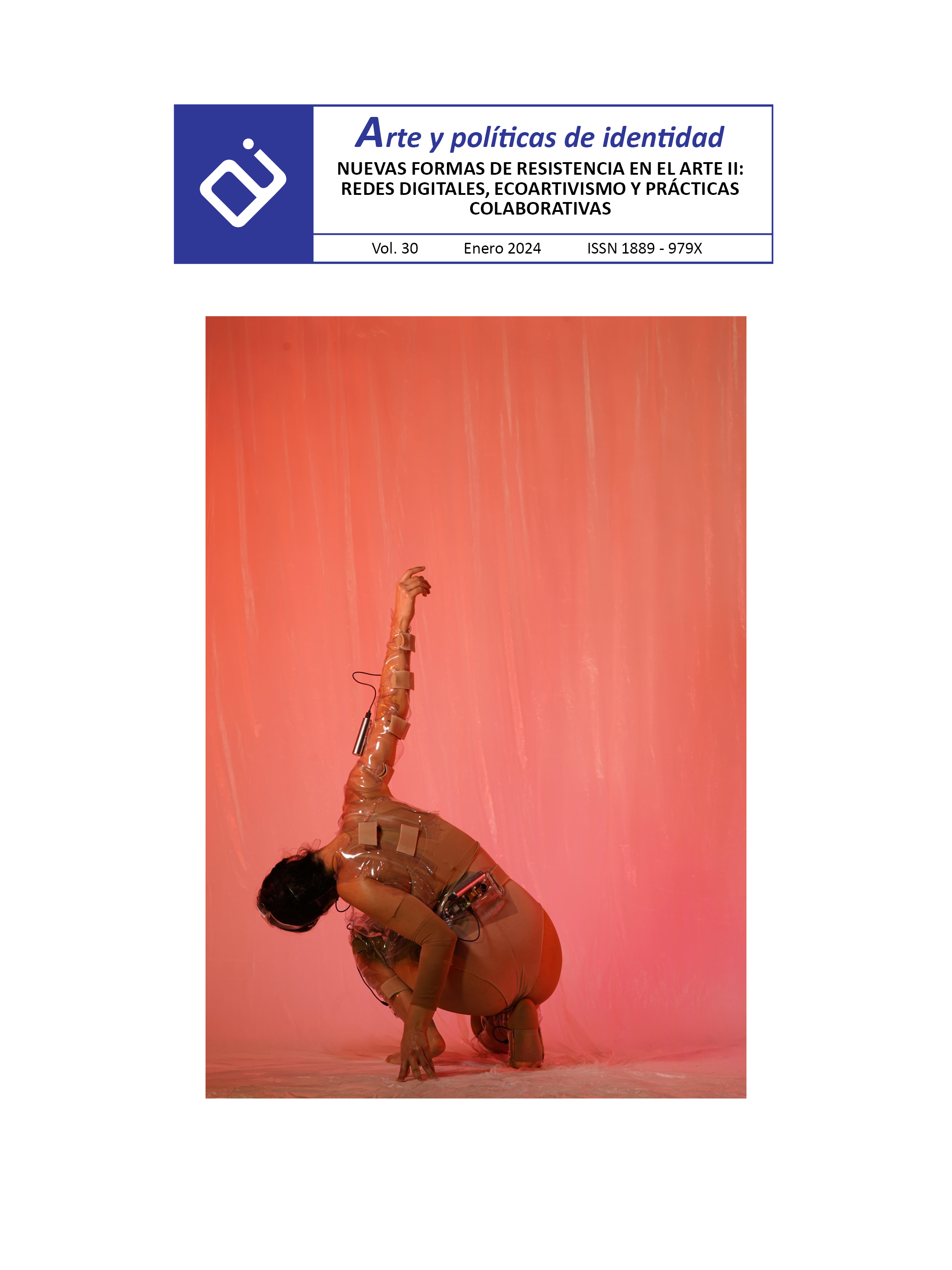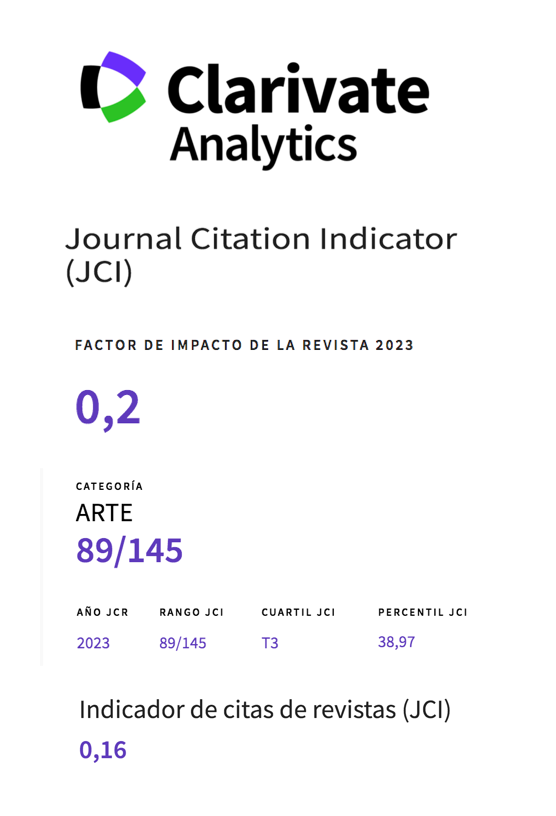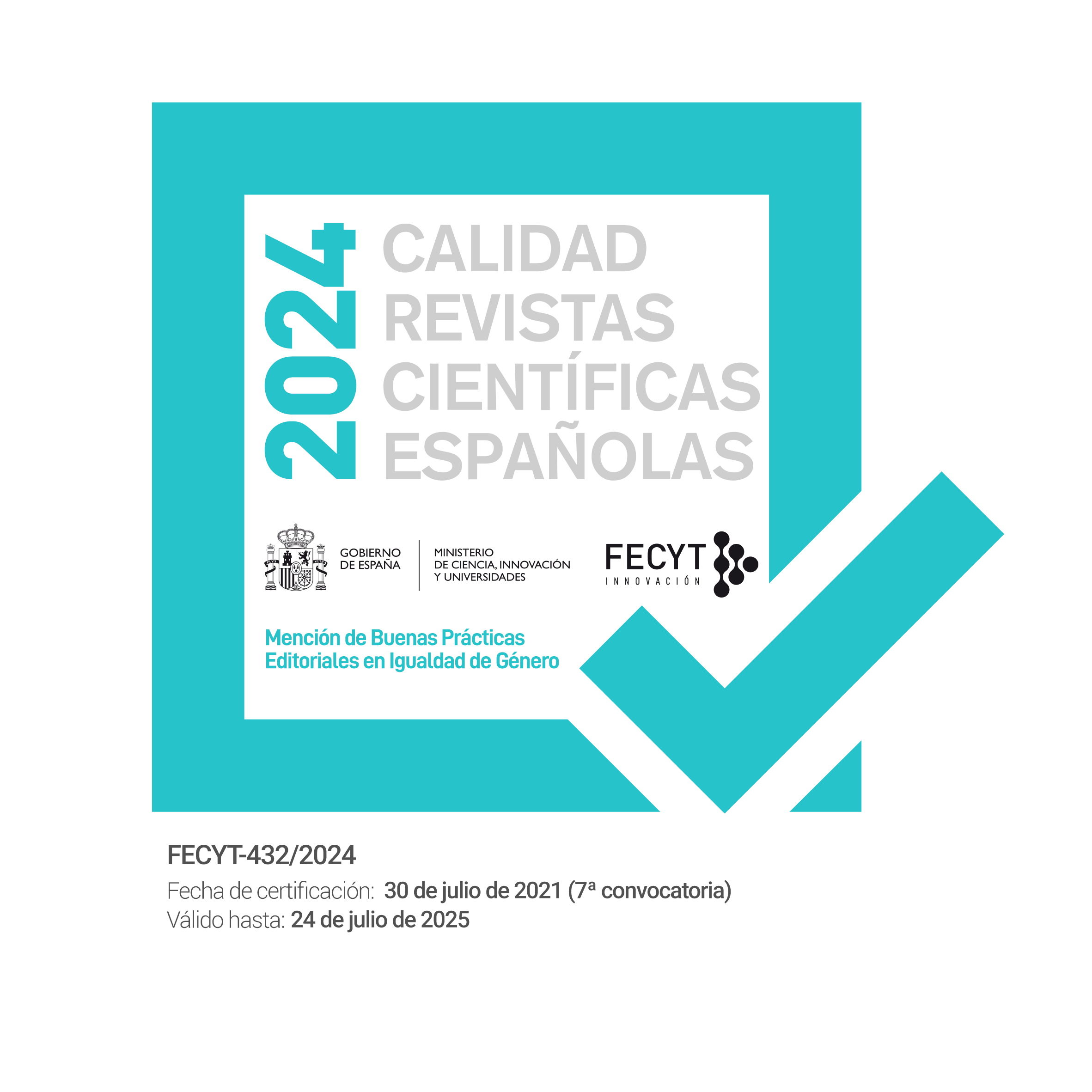RESPECT EXISTENCE OR EXPECT RESISTANCE (des)Aprender desde/ en/ a través del arte
Resumen
El lema que da título a este artículo es una expresión utilizada a lo largo de los años para visibilizar reivindicaciones de distinta índole. En este sentido, se plantea aquí la posibilidad de aplicarlo a nuestro trabajo como docentes, artistas y/o investigadoras, comprendiendo, de esta manera, el arte y, por tanto, su producción, enseñanza o investigación, como un acto de resistencia. Así nos preguntamos por un tipo de actividad artística cuya aportación visibilice y localice lo que la realidad normativa con sus pactos e intereses, oculta o deja al margen. Para ello, se analizan dos obras: el trabajo audiovisual Swinguerra (2019) de Barbara Wagner y Benjamin De Burca y el proyecto expositivo La levadura y el anfitrión (2017) creado por Philippe Parreno. Se tratan, en ambos casos, de obras sin centro que, mediante lo queer y lo relacional, constituyen, según nuestra hipótesis, contextos privilegiados de des-aprendizaje y, por lo tanto, de aprendizaje, pues tanto una como otra, en su despliegue ante los públicos, pone de manifiesto una clara resistencia a los pactos de la realidad, generando de este modo inmejorables escenarios y situaciones de aprendizaje.
Descargas
-
Resumen256
-
pdf201
Citas
Amor, M. (2021). From Plasticity to Elasticity: Philippe Parreno’s Permanent Revolution. Oboe Journal, 2(1), 4-21. https://doi.org/10.25432/2724-086X/2.1.0001
Arcoverde de Oliveira, B. (2021). Cannibalizing The Popular In The Work Of Barbara Wagner. Lindenwood University. https://digitalcommons.lindenwood.edu/cgi/viewcontent.cgi?article=1048&context=theses
Aubin, Ch. (s.f.). In Conversation. Bárbara Wagner and Benjamin de Burca. Performa Magazine 12. https://performa-arts.org/magazine/inconversation-interviewwagnerburca
Badiola, T. (2017). Arte, educación, amor al arte. Eremuak 4, 15-24. https://eremuak.eus/web/wp-content/uploads/2018/01/eremuak4_cas_eus.pdf
Barad, K. (2012). Intra-actions, Interview of Karen Barad by Adam Kleinmann. Mousse Magazine 34, 76-81.
Baraúna, D. (2022). Besideness: distance and proximity as queer disorientations to inhabit projective moving image installations. Frames Cinema Journal 20, 37-66.
https://doi.org/10.15664/fcj.v20i0.2511
Bloom, I. (2016). On Snow Dancing. Superhumanity. e-flux Architecture. https://www.e-flux.com/architecture/superhumanity/66881/on-snow-dancing/
Bollen, J. (2001) Queer Kinesthesia: performativity on the dancefloor. In Dancing desires: Choreographing Sexualities On and Off the Stage. University of Wisconsin Press.
Bourriaud, N. (2015). Estética relacional. Adriana Hidalgo Editora.
Cabello/Carceller. Proyectos: Locura Social (Agustina González López), 2019.
https://www.cabellocarceller.info/es/locura-social-agustina-gonz%C3%A1lez-l%C3%B3pez
Colby, C. (2022). Claiming their space through dance. ‘Swinguerra’ highlights queer Brazilian dancers. The Bay State Banner, March 30th, 2022. https://www.baystatebanner.com/2022/03/30/claiming-their-space-through-dance/
Deleuze, G. y Guattari, F., (2004). El Anti Edipo: capitalismo y esquizofrenia. Paidós Ibérica.
Fundación Jumex (2017). Montaje: Philippe Parreno. Marquee (Marquesina) [Vídeo de proceso de montaje de obra artística]. https://www.fundacionjumex.org/es/explora/videos/52-montaje-philippe-parreno-_marquee_-marquesina-2017
Garcés, M. (2013). Un mundo común. Edicions Bellaterra.
Guattari, F. (1986). De la production de la subjectivité. Revue Chimères, 4,1-19.
Haraway, D. J. (1991). Ciencia, cyborgs y mujeres: la reinvención de la naturaleza. Ediciones Cátedra.
Haraway, D. (2003). The Companion Species Manifesto: Dogs, People, and Significant Otherness. Prickly Paradigm Press.
Lindner, K. (2017). Film Bodies: Queer Feminist Encounters with Gender and Sexuality in Cinema. I.B. Taurus.
Lyotard, J. F. (1985). Les immatériaux (Vol. 1). Centre Georges Pompidou.
Lucchetti, M (s.f.) Recife Bárbara Wagner & Benjamin de Burca on the Complexity of an Encounter. Extra Extra Magazine, 13. https://extraextramagazine.com/talk/barbara-wagner-benjamin-de-burca-on-the-complexity-of-an-encounter/
Moraza, J.L. (2009). El Deseo Del Artista, Notas para una investigación artística. Transcripción establecida por Carmen Delgado y corregida por el autor de la conferencia dictada en el Colegio de Psicoanálisis en abril 2009. Transcripción publicada en la edición de Carmen Gallano: El deseo. Textos y conferencias. Colegio de Psicoanálisis del Campo Lacaniano de Madrid.
Parreno, P. (2013, octubre, 24). Philippe Parreno by Dario Khondji. Interview Magazine.
https://www.interviewmagazine.com/art/philippe-parreno
Parreno, P. (2015, noviembre, 30) Interview of Philippe Parreno by Tom Eccles. ArtReview. https://artreview.com/october-2015-feature-philippe-parreno/
Parreno, P. (2019, noviembre, 9) A Sequel to Les Immatériaux? Postmoderns and After? 40 years after The Postmodern Condition. Conferencia en China Academy of Art, Hangzhou, China.
Rogoff I. (2008)-(2011) El Giro. Arte y políticas de identidad, 2011, vol. 4 (junio), 253-266 . Traducción del Inglés: Estíbaliz Encarnación Pinedo. Versión original: Rogoff I. Turning. E – flux Journal. Issue #00. 10/08. November 2008, 1-7. https://editor.e-flux-systems.com/files/68470_e-flux-journal-turning.pdf
Serres, M. (1982) The Parasite. Johns Hopkins UP.
Spivak G. (1988). Can the subaltern speak? en Nelson C. y Grossberg L. (Eds.) Marxism and the Interpretation of Culture. Macmillan. https://jan.ucc.nau.edu/~sj6/Spivak%20CanTheSubalternSpeak.pdf
Thirlwell, A., y Parreno, P. (2017). Conversa: Um guiao com Philippe Parreno por Adam Thirlwell. Fundación Serralves.
Zahm, O. y Parreno, P. (2017). PHILIPPE PARRENO. Entrevista de Olivier Zahm. En: J. González. Exhibition Booklet for The Yeast and The Host. Jumex Museum, Mexico City.
Derechos de autor 2024 Servicio de Publicaciones de la Universidad de Murcia

Esta obra está bajo una licencia internacional Creative Commons Atribución-NoComercial-SinDerivadas 4.0.
Works published in this journal are subject to the following terms:
- The Service of Publications from the University of Murcia (publishing house) keeps the published works’ copyrights, and favors and allows the reuse of these works under the license indicated in point 2.
- Works are published in the journal’s online edition under the license Creative Commons Reconocimiento-NoComercial-SinObraDerivada 3.0 España(texto legal). They can be copied, used, disseminated, transmitted and publicly exhibited, as long as: i) the author and original source of publication are cited (journal, publishing house and work’s URL); ii) they are not used for commercial purposes; iii) the existence and specifications of this license are mentioned.
3. Conditions for auto-file. It is allowed and encouraged that authors share electronically their pre-print version (the pre-reviewed version) and /or post-print version (the reviewed and accepted version) of their Works before the publication, since it promotes its circulation and dissemination. RoMEO color: green.










